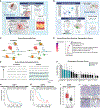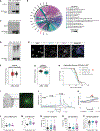Glioma epileptiform activity and progression are driven by IGSF3-mediated potassium dysregulation
- PMID: 36787748
- PMCID: PMC9991983
- DOI: 10.1016/j.neuron.2023.01.013
Glioma epileptiform activity and progression are driven by IGSF3-mediated potassium dysregulation
Abstract
Seizures are a frequent pathophysiological feature of malignant glioma. Recent studies implicate peritumoral synaptic dysregulation as a driver of brain hyperactivity and tumor progression; however, the molecular mechanisms that govern these phenomena remain elusive. Using scRNA-seq and intraoperative patient ECoG recordings, we show that tumors from seizure patients are enriched for gene signatures regulating synapse formation. Employing a human-to-mouse in vivo functionalization pipeline to screen these genes, we identify IGSF3 as a mediator of glioma progression and dysregulated neural circuitry that manifests as spreading depolarization (SD). Mechanistically, we discover that IGSF3 interacts with Kir4.1 to suppress potassium buffering and found that seizure patients exhibit reduced expression of potassium handlers in proliferating tumor cells. In vivo imaging reveals that dysregulated synaptic activity emanates from the tumor-neuron interface, which we confirm in patients. Our studies reveal that tumor progression and seizures are enabled by ion dyshomeostasis and identify SD as a driver of disease.
Keywords: brain hyperactivity; glioma; glioma-related epilepsy; potassium dysregulation; spreading depolarization.
Copyright © 2023 Elsevier Inc. All rights reserved.
Conflict of interest statement
Declaration of interests The authors declare no competing interests.
Figures






Comment in
-
A Salt in the Buffer Zone: Potassium Dysregulation Drives Glioma Growth?Epilepsy Curr. 2023 Aug 8;23(5):309-311. doi: 10.1177/15357597231193318. eCollection 2023 Sep-Oct. Epilepsy Curr. 2023. PMID: 37901777 Free PMC article. No abstract available.
References
Publication types
MeSH terms
Substances
Grants and funding
- F31 CA265156/CA/NCI NIH HHS/United States
- F99 CA274700/CA/NCI NIH HHS/United States
- S10 OD025240/OD/NIH HHS/United States
- K08 NS110976/NS/NINDS NIH HHS/United States
- T32 HL092332/HL/NHLBI NIH HHS/United States
- U01 CA217842/CA/NCI NIH HHS/United States
- R01 NS071153/NS/NINDS NIH HHS/United States
- P30 CA125123/CA/NCI NIH HHS/United States
- P30 EY002520/EY/NEI NIH HHS/United States
- R01 NS029709/NS/NINDS NIH HHS/United States
- R01 NS094615/NS/NINDS NIH HHS/United States
- S10 OD026804/OD/NIH HHS/United States
- R01 CA223388/CA/NCI NIH HHS/United States
- R01 NS124093/NS/NINDS NIH HHS/United States
- S10 OD023469/OD/NIH HHS/United States
LinkOut - more resources
Full Text Sources
Medical

